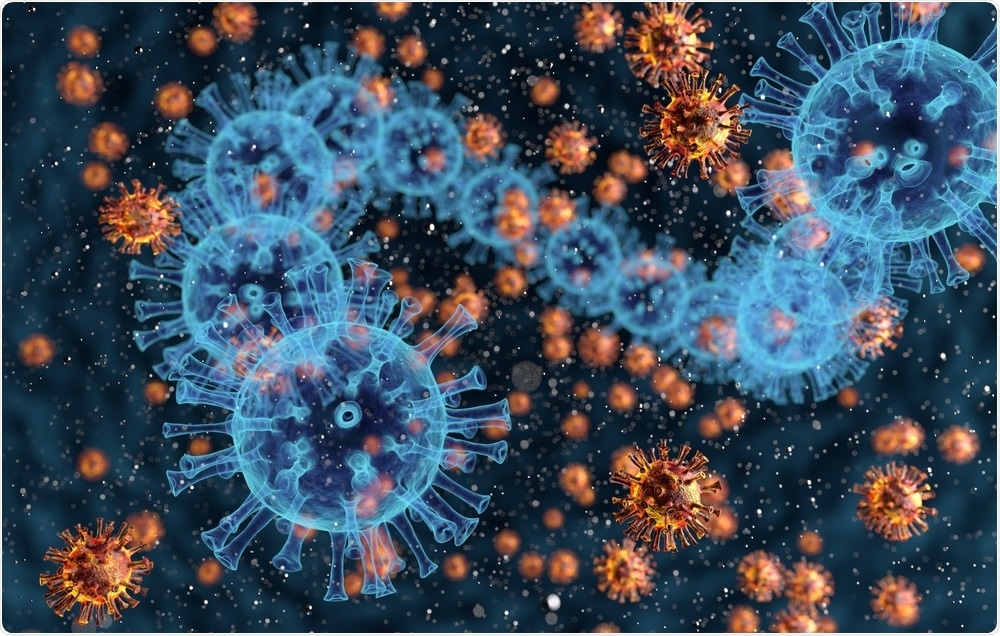The open reading frame 10 (ORF10) protein of the severe acute respiratory syndrome coronavirus 2 (SARS-CoV-2) interacts with multiple human proteins expressed in lung tissues. Mutations and co-occurring mutations in the ORF10 strongly impact the virulence and pathogenicity of SARS-CoV-2. The surveillance of ORF10 mutations is therefore crucial for developing potent medical and pharmaceutical interventions against SARS-CoV-2.

Study: Emergence of unique SARS-CoV-2 ORF10 variants and their impact on protein structure and function. Image Credit: Iurii Kachkovskyi / Shutterstock.com
About the study
In a review published in the International Journal of Biological Macromolecules, researchers examined 140 unique SARS-CoV-2 ORF10 sequences among 202,968 ORF10 sequences retrieved from the National Center for Biotechnology Information (NCBI) database. They used the Phobius program to predict the transmembrane topology of SARS-CoV-2 ORF10 protein variants and subjected them to the intrinsic disorder analysis with the PONDR-VSL2 algorithm.
Single mutations in ORF10 proteins were determined using the Virus Pathogen Resource (ViPR), and the frequency distribution of each amino acid in this sequence was determined using standard bioinformatics routine in Matlab.
Evaluating the distribution of unique ORF10 variants and mutations
Unique SARS-CoV-2 ORF10 variants were reported from all six continents including South America, Europe, Asia, Oceania, Africa, and North America. While Africa had the highest percentage of unique variants of ORF10 sequences at 1.27%, the highest frequency of the most unique ORF10 variants was reported in North America.
The researchers noticed that all amino acid residues in ORF10 variants from position 1 to 38, except position 18, showed a point-missense mutation. Of a total of 37 residue positions with single mutations, the residue positions 1, 2, 11, 12, 15, 16, 20, 21, 25, 26, 27, 29, 32, 34, and 36 were unique in North America. However, only single mutations at positions 11 (F11S, F11L) and 16 (L16P) reported in North America appeared detrimental.
The unique ORF10 variants from Asia, Africa, and Oceania had several single mutations at common residue positions. However, the two mutations of S23F and S23P in residue S23 were reported across all six continents.
Interestingly, the observed unique variations in the SARS-CoV-2 ORF10 variants, especially the co-occurring mutations, appear to be an emerging trend across different continents. These ORF10 variants with co-occurring mutations might be transmitted to other geo-locations in the future when the pandemic-related travel bans end.
Several co-occurring mutations in SARS-CoV-2 ORF10 variants were observed in the United States, United Kingdom, India, South Africa, Spain, Germany, Greece, Mexico, and Russia. Of 22 unique co-occurring mutations observed in different geographical locations, the highest number of co-occurring mutations were reported in March 2021 in a SARS-CoV-2 ORF10 variant from Russia, which exhibited mutations in 14 amino acid residues.
The most commonly co-occurring mutations V30L and T38I were first reported in Spain in 2021 and there were no single-point mutations at the residue positions 1 and 2. In the U.S., co-occurring mutations M1K, G2A, Y3D, I4G, N5L, V6Y, F7K, and A8R were reported; however, none of them was a single mutation in the ORF10 variants.
Surprisingly, the pathogenic effects of double co-occurring mutations P10S and V30l were found to be neutral. Furthermore, V30L, one of the most common mutations in ORF10, was co-occurring with most of the other co-occurring mutations. Several mutations such as L17I, A8T, V6M, N34P, and F35Q did not appear as a single mutation and only appeared as one of the co-occurring mutations.
It was also observed that the effects of co-occurring mutants are qualitatively similar to those of single mutations, as most variability is around a region centered at residue 25 and at N- and C-terminal regions of the protein. However, in co-occurring mutants, as compared to single mutations, scales of changes at the terminal regions are significantly larger. Consequently, these mutations may affect the secondary structure and associated functions of the ORF10 variants.
Conclusions
The current study shows that mutations in the SARS-CoV-2 ORF10 variants, especially co-occurring mutations, are emerging across different continents, with the highest number of single mutations and co-occurring mutations in North America. A possible explanation for this could be that North America is the origin of the largest number of sequenced SARS-CoV-2 isolates. Also, the nations in this continent have implemented different approaches for controlling SARS-CoV-2 transmission locally, thus generating conditions for the locally diversified evolution of SARS-CoV-2.
The study findings also demonstrate that the growth rate of non-synonymous ORF10 mutations is increasingly non-linear, thereby raising questions on the stability or instability of emerging SARS-CoV-2 variants. A significant percentage of observed non-synonymous mutations are detrimental, which can alter the expression of the SARS-CoV-2 ORF10 proteins and subsequently affect functional virus-host protein-protein interactions.
Furthermore, co-occurring mutations have significantly changed the secondary structure, particularly the α helix regions of the ORF10 variants. The presence of these mutations can influence the virulence/pathogenicity of SARS-CoV-2 directly or indirectly, which makes continuous surveillance of mutations and their associated effects crucial.
Journal reference:
- Hassan, S. S., Lundstrom, K., Serrano-Aroca, A., et al. (2021). Emergence of unique SARS-CoV-2 ORF10 variants and their impact on protein structure and function. International Journal of Biological Macromolecules. doi:10.1016/j.ijbiomac.2021.11.151.